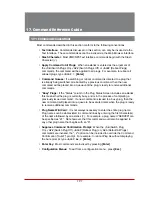
14-2
Creating Web Certificates
14.1. Creating a Self Signed Certificate
To create a Self Signed certificate, access the Text interface using a password that
permits access to Administrator level commands and then proceed as follows:
1. Type
/N
and press
[Enter]
to display the Eth0/IPv4 (Shared) Network
Parameters menu.
2. At the Eth0/IPv4 Network Parameters menu, type
23
and press
[Enter]
to display
the Web Access menu (Figure 14.1.) Type
3
and press
[Enter]
and then follow the
instructions in the resulting submenu to enable HTTPS access.
3. Next, use the Web Access menu to define the following parameters.
Notes:
• When configuring the VMR/NPS, make certain to define all of the following
parameters. Although most SSL/TLS applications require only the Common
Name, in the case of the VMR/NPS all of the following parameters are
mandatory.
• If desired, any random text sequence can be entered in each of these fields.
•
5. Common Name:
A domain name that will be used to identify the VMR/NPS
unit. If you will use a Self Signed certificate, then this name can be any name
that you choose, and there is no need to set up your domain name server to
recognize this name. However, if you will use a Signed certificate, then your
domain name server must be set up to recognize this name
(e.g., service.yourcompanyname.com.)
•
6. State or Province:
The name of the state or province where the VMR/NPS
unit will be located (e.g., California.)
•
7. Locality:
The city or town where the VMR/NPS unit will be located (e.g.,
Irvine.)
•
8. Country:
The two character country code for the nation where the VMR/NPS
will be located (e.g., US.)
•
9. Email Address:
An email address, that can be used to contact the person
responsible for the VMR/NPS (e.g., [email protected].)
•
10. Organizational Name:
The name of your company or organization
(e.g., Yourcompanyname, Inc.)
•
11. Organizational Unit:
The name of your department or division.






























